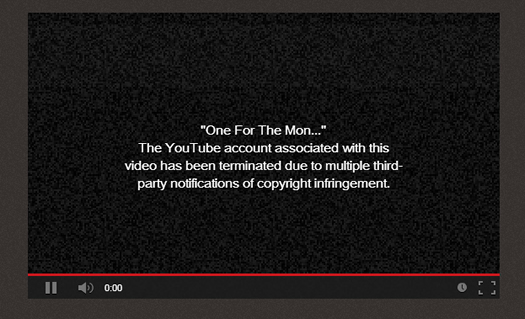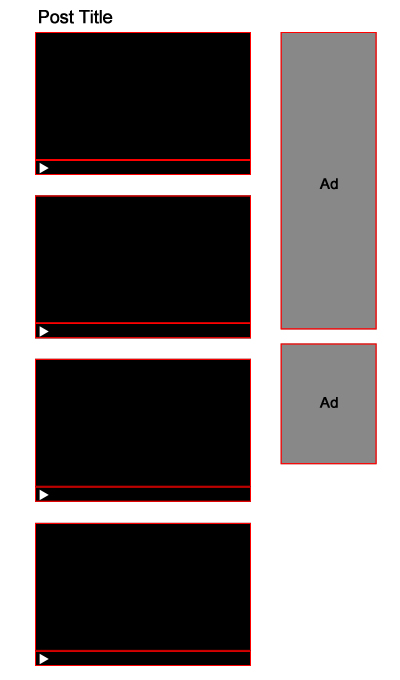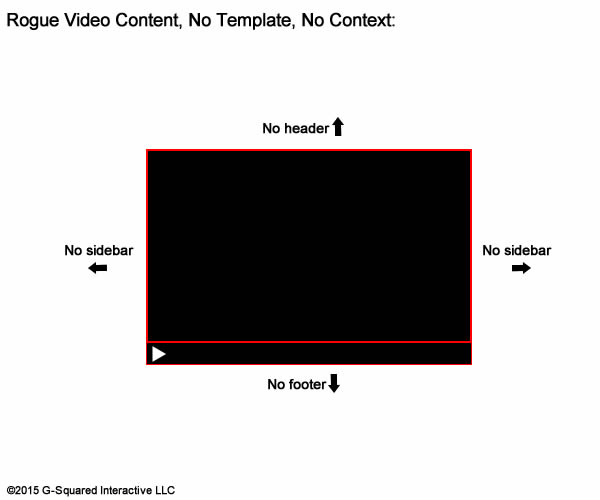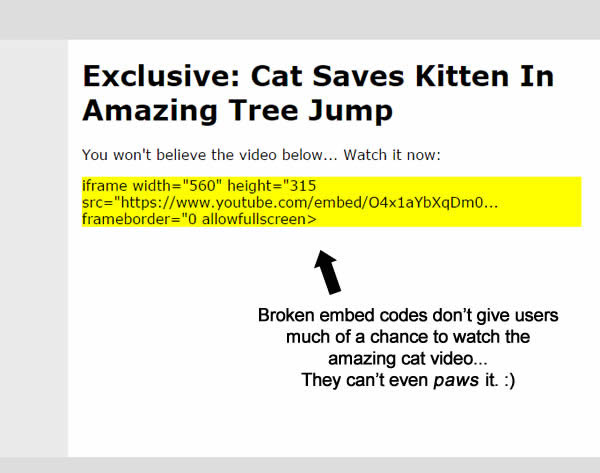
When helping companies deal with declining rankings or an algorithm hit, it’s important to thoroughly identify low-quality content. And that’s especially true if a site has been hit by Panda (or if it’s susceptible to getting hit by Panda). Low-quality content can negatively impact user engagement, which is a strong signal to the engines whether or not user expectations are met. For example, are users spending time on the site once clicking through from the search results? Or are they bouncing back to the SERPs (which yields low dwell time)?
Video is a great way to provide rich content, but depending on the implementation and strategy, it can also be dangerous SEO-wise. Larger-scale sites that heavily use embedded video tend to run more risk than others (since content problems can lie undetected for a long time). After seeing many examples of "video bamboo" during audits, I wanted to provide a few of the core problems I have surfaced. My hope is that webmasters can evaluate their content strategy, weed out video problems, and increase the amount of high-quality content on their websites.
4 Risky Types of Video Problems
The four problems listed below are not the only video problems you will come across from a content quality perspective, but they do cover important areas. I’ll cover each problem I’ve surfaced and then provide some quick tips and recommendations for dealing with those situations. Let’s jump in.
1. White Noise (Literally and Figuratively)
This problems rears its ugly head typically on larger-scale sites that have used embedded video content heavily over the years. I’ve seen the problem often while analyzing Panda hits, but I have also come across the problem on sites seeing gradual declines over time. In a nutshell, the source video is simply not present anymore. The embed code attempts to display the video, but can’t, since the source is gone. This can be due to a number of reasons, which are often out of the control of the site owner.
For example, videos can be removed due to copyright violations. When that happens, you can literally see white noise as the video content with a simple message saying the video has been removed due to copyright problems. As you can guess, if the page was ranking and driving traffic, then this provides a horrible user experience once users hit the site. There’s a solid chance those users will bounce off the site right back to the search results. And low dwell time is an incredibly strong signal to the engines that something went horribly wrong with the visit.


In addition to copyright violations, the original owner may have simply removed the video. In that case, you’ll see a blank video (just black screen) with a message that the content has been removed.
Again, this provides a horrible user experience and will almost guarantee a bounce back to the search results. And when Google sees low dwell time in aggregate, you can rest assured that problematic pages will not rank highly anymore. And worse, if this is happening widely across the site, then you can run into Panda problems.


Basically, you have the ultimate recipe for destroying rankings. Horrible user experience, low dwell time, and broken content. Not good, to say the least.
2. Stacked Videos
During audits I have also come across pages containing "stacked videos." That’s where a page contains a number of videos, all stacked vertically throughout the page (with little supporting content). So you might have three, four, five, or more embedded videos in a single post as the primary content. Needless to say, this typically makes for a clumsy user experience, can cause performance problems for users, and can end up sending horrible signals back to the engines.


By the way, that’s on desktop… Imagine four videos stacked on a page you’re viewing on a mobile device. I bet you’ll be screaming in pain as you attempt to play and traverse the content. When runningPanda reports, it’s not unusual to come across pages like this. They might have ranked well at one time, but ended up dropping off a cliff after an algo hit. My recommendation is to evaluate the core purpose of the page, break videos up if needed, or just nuke certain videos to enhance the user experience.
Also, and I touched on this earlier, I don’t recommend heavily using embedded video as your content strategy. It’s not your own content, can easily be found elsewhere, and can make your website look like a scraper site (in aggregate). I’m not saying to never embed videos. That’s ridiculous…but you should provide unique and compelling content in a user-friendly way.
3. Thin Content, Rogue Video
When hunting down low-quality content, an audit can surface various forms of thin content. Video-wise, there are times I come across pages that contain nothing but the video embed. The page is essentially blank to the engines other than the embed code. There’s not a description, there’s no copy, related content, etc. Instead, there’s simply the video.
And to make matters worse, I sometimes find rogue video pages. These are disconnected pages that don’t even contain the site template, the main navigation, etc. They are nearly blank pages that simply contain the video. Needless to say, rogue pages can throw users for a loop, pun intended. Not only can users be extremely skeptical of the page and site based on the lack of design, but they can’t easily navigate to another area of the site based on the lack of navigation. It’s an engagement killer.


Side Note: Two Quick Examples of Bolstering Video Pages
Instead of providing thin video pages or rogue video pages, I recommend bolstering your video content. Two strong examples of doing this sit right in our industry. First, Moz always provides a video transcript with their Whiteboard Friday videos. By providing the transcript, users can easily scan and search the text for specific areas of the video, while search engines can crawl and index all of the textual content. This is smart on several levels.


Annie Cushing’s videos are another great example. Annie has started producing more training videos and uses a slightly differently approach than Moz. She typically provides video tutorials, but also provides a lite version of the video tutorial in the blog post (using text and images). Similar to the Moz situation, users can find useful pieces of content in the post, while search engines can crawl and index the content. So you have benefits for both users and search engines. Again, very smart.


4. Broken Embed Codes
The next video situation that can lead to low-quality content involves broken embed codes. When performing a large crawl, I sometimes surface pages that are supposed to contain a video, but simply display broken embed codes. So the pages have no shot at meeting user expectations, and instead, can destroy the credibility of the site in question.


In my experience, this can happen when major changes get implemented on a website or CMS. The change rolls out, most of the pages are unaffected, but the video embed code breaks on certain pages (or all video pages). There’s no way to identify this problem unless you are continually analyzing your content via crawls or manual audits. So the problem can sit for a long time. And for larger websites, this can end up impacting hundreds, or even thousands, of webpages.
Un-Breaking the Broken
The best way to combat this from happening is to set recurring crawls of the site. This will help you identify technical errors, content quality problems, etc. As you dig into the crawl, you can end up surfacing pages with broken embed codes. In addition, you can use crawling tools like Screaming Frog or DeepCrawl to look for specific pieces of code (like the embed code). Then you can take that subset of the crawl and conduct a deeper analysis.
Removing Video Bamboo - Tips and Recommendations
If you heavily use video content on your site, and have for a long time, then it’s important to be aware of the potential problems SEO-wise. Below, I’ll provide some quick bullets to help you get moving in the right direction. The goal is to identify video problems relatively quickly, and then execute changes to rid the site of issues that can be negatively impacting user engagement, content quality, and SEO overall.
- Identify Video Pages (The Obvious)In order to effectively analyze video pages, you need to identify them first. That will enable you to cut through the noise and focus on pages containing video content. One way to do this is to leverage the naming convention used on the site. For example, if video pages always contain a certain word or directory, then you can filter landing pages in Google Analytics by that text. That could be "video," "media," or other words present in the URL or titles.
- Crawl the Site/PagesBy crawling your site via a tool like Screaming Frog or DeepCrawl, you can process pages in bulk. Then you can look for problems across many pages at one time. For example, I mentioned earlier that you can look for specific pieces of code when you crawl a site (like video embed codes). That can help you surface pages that have the potential for causing video-related problems like the ones I mentioned above.
- Identify Pages With High ABRFirst, if you haven’t implemented adjusted bounce rate yet, do it today. It will enable you to gain a stronger view of bounce rate than using standard bounce rate (which is flawed). Once you do, you can export your top landing pages from Google analytics and sort by ABR. Then you can identify high ABR pages, which can signal pages that users are not spending a lot of time on. You control the time threshold when setting up ABR, so analyzing high ABR pages would be a smart move. And during that process, you might find video pages causing problems.
- Act! Don’t Just AnalyzeOnce you have identified video-related problems, you need to act. Don’t be proud of yourself for digging up a big problem, while nothing changes on the site. Organize the problems you surfaced and develop a remediation plan. That might include fixing broken videos, removing videos that have copyright issues, updating videos that have changed, 404ing pages that are out of date, etc. Your goal is to increase content quality on the site and tackling these issues can help you do that.
Summary – Video Bamboo Is Still Bamboo
Video can be a strong component of a rounded content strategy, but it can also cause serious problems SEO-wise. And that’s especially the case on larger-scale sites with thousands of pages of content (or more). Video problems can sit deep on a website, off a webmaster’s radar, while negatively impacting user engagement, content quality, and SEO overall. Don’t let that happen to you. Dig into your site, crawl your Web pages, and identify video issues causing problems. If you do, you can make both users and search engines happy. And that’s always a good thing.
To view the original article Click Here

This blog is very informative. You have explained it well. For many marketers, video content is the leading step in a content marketing plan, as more marketers lean on video content as an effective way to cut through the crowded content marketing landscape. Creating video and hosting it on your company site or posting it out on any social media is a way to show that your brand is technologically savvy but don’t just produce videos for promotional purposes. Video has to be done right to be effective. This blog will discuss the pros and cons of video as content marketing strategies and explain best practices that digital marketers can look for support in their own video content marketing. That’s why we need to read this and follow the tips. If we haven’t thought of video marketing, now is a great time to get started. With affordable advertising and tremendous search engine exposure, this rich form of media will help our business obtain more publicity.
ReplyDeleteMichael Talburt @ Whitehat SEO
Hi Michael, just noticed the pics weren't working, thanks for the kind comments, glad you liked it. :)
Delete